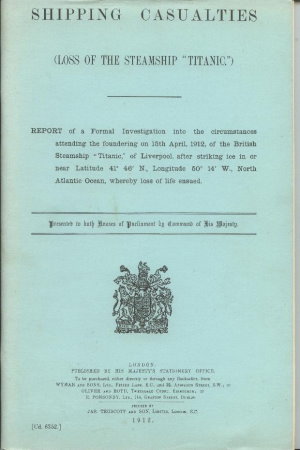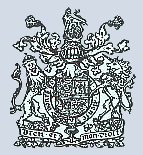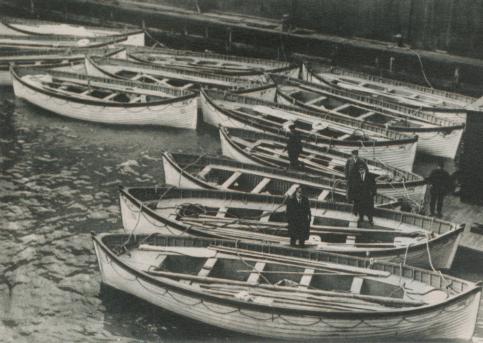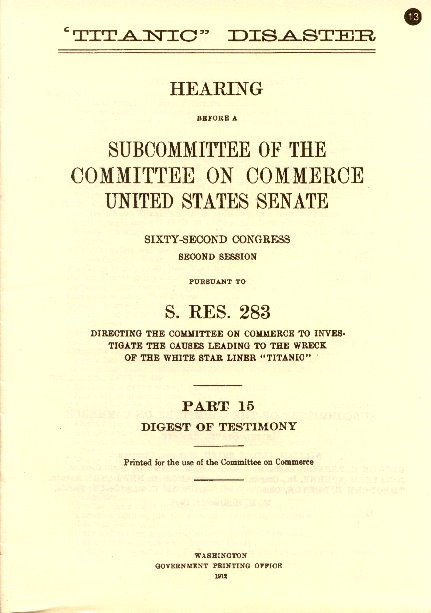
NEXT - TITANIC DISCOVERED 1985
The Board of Trade drafted an Amendment to the Rules, suggesting that vessels of the size of the Titanic should carry at least 26 lifeboats.
|
|
|
|
|
|
|
|
|

Titanic Inquiry & Aftermath |
THE BRITISH INQUIRY The final report into the loss of the Titanic was presented to both Houses of Parliament by command of his majesty King George V. The investigation was held at the Scottish Hall, Buckingham Gate, Westminster, London. It started on the 2nd May 1912. The Right Honourable Lord Mersey, Wreck Commissioner presided. Several prominent assessors aided him. Rear Admiral the Honourable S.A. Gough-Calthorpe, CVO RN; Captain A.W. Clarke Commander FCA Lyon RNR; Professor J.H. Biles DSc LLD and Mr. E.C. Chaston RNR. For convenience, the Hearing has been split into days. The Full Report in PDF format below. The Report will open in a new window and simply save it once loaded. Please be patient whilst it loads. The Report was divided into eight sections as below:
It is the writer's aim to consider sections 5-8 as most of the other detail regarding the ship has already been covered. The circumstances in connection with the SS Californian The Carpathia raced to the rescue of the Titanic to the position recorded where the Titanic had foundered as 41° 46' N, 50° 7'W. The Captain of the Californian had logged their position as being 42° 5'N. 57° 7'W; only 19 miles away. Was this an accurate position? The Captain of the California was Mr. Stanley Lord. He himself spend little time on the bridge that night and was guided by his officers. At 11 p.m. a steamer's lights were seen approaching from the east. Lord went to the wireless room to see which ships were in the area. He asked Evans, the wireless operator. "I think the Titanic is near us. I have got her." He meant that he had picked up the Titanics Marconi signals. Lord told Evans to send a message to the ship advising them that they had stopped due to the ice. Evans complied but he was told to "keep out" by the Titanics wireless operator. The Titanic had been conversing with Cape Race and did not want to lose the faint signal. They continued to listen to Cape Race until 11.30 p.m. The Master told the court that by 11.30 p.m. his ship was only about five miles from the Titanic and he could clearly see deck lights. There was also some discrepancy from witness statements to the Court about the rockets fired from the Titanic. Second Officer Stone had counted eight white rockets in total, the first of which had been fired at around 1.40 p.m. He did not report the rockets for twenty minutes but merely observed the steamer. Eventually he told his apprentice to wake the Master and advise him that the Ship had fired eight rockets. However, no official records have been kept in the log. There are contradictions and inconsistencies in the story as told by different witnesses but the matter was clear to the Court. "The Titanic collided with the berg at 11.40 p.m. The vessel seen by the Californian was the Titanic. The rockets sent up by the titanic was about eight. The Californian saw eight ………. At 2.40 a.m. Mr. Stone called to the Master that the ship from which he had seen the rockets had disappeared. At. 2.20 a.m. the titanic foundered." The circumstances convinced the Court that the Californian was no more than five to ten miles away when the Titanic disaster happened. She could have found her way through the ice to clear water and assist the Titanic with the evacuation. Had she done so she might have saved the lives of many if not all the lives that were lost. The Board Of Trade's Administration The Court had been invited by the Board of Trade "to report upon the Rules and Regulations made under the Merchat Shipping Acts 1894-1906 and the Administration of those Acts and of such Rules and Regulations so far as the consideration thereof is material to this casualty." During the course of the Enquiry two principal charges were made against the Board. The Board had been negligent in that they failed to update their rules and regulations relating generally to the provision of lifeboats.
It is pointed out as background that in 1887 a Select Committee of the House of Commons was appointed to report on Saving Life at Sea. They found that many passenger ships could not, without great "inconvenience, carry so may ordinary wooden boats as would suffice to carry the whole of the passengers and crew with safety in bad weather." They thought that so many boats could not be launched at a time of crisis and would be ineffectual. As a result, the Merchant Shipping Life Saving Appliances) Act 1888 was passed. It was later repealled by the 1894 Merchant Shipping Act which only partially improved lifeboat provision. The new Act contained tables outlining how many life boats were needed calculated by the gross tonnage of the ship. The tables however, stopped calculating at 10,000 tons which would require 16 lifeboats. When the Titanic was built in 1911 the builders routinely relied upon these regulations when providing for life boats aboard. They knew the gross tonnage was 46,328 and that 16 lifeboats would not carry all the passengers in an emergency. One would have thought the necessity for increased lifeboat accommodation would have been obvious but the rules remained the same. The designers did not take it on board themselves to provide extra boats but instead they followed the law to is last letter. An explanation was given by Sir Alfred Chalmers who served under the Board as Nautical Advisor from 1896 to August 1911. He told the Court that the shipbuilding industry had come along way and safer ships were being constructed. He found travelling by sea the most safest mode of travel in the world. He justifed the low level of boats required by explaining that an increase in level of boats aboard would be ineffective when it came to disasters because there would be too many to launch. He argued that the new wireless was a means of preempting danger which would then be avoided. His argument was convincing but was simplistic as proved by the loss of the Titanic proved this. The Court recognised that 16 lifeboats and the four collapsibe lifeboats were insufficient for a 45,000 ton vessel. The Titanics Sister Olympic carried only 14 boats and 2 ordinary ones but again it was well in excess of the Regulations. Scale drawings were introduced by the White Star Line to illustrate how big and how many boats would have to be to accommodate all the passengers. To seat all the Titanic passengers boat capacity would have to be 24,937 cubic feet, allowing 10 cubic feet per person. The Board of Trade drafted an Amendment to the Rules, suggesting that vessels of the size of the Titanic should carry at least 26 lifeboats. The construction of the Titanic It was seen that the Titanic was efficiently designed and constructed to meet the contingencies which she was intended to do. Eventhough the bulkheads were strong enough and went sufficiently high in the ship to meet the requirements of the 1891 Bulkheads Committee, they did not save the ship. Had the Titanic been further sub-divided she would probably have remained afloat longer as the Board of Trade did not have any power of supervision over the construction of ships it was suggested that this should change. In future, the Board should be empowered to require the production of the designers of all passenger steamers at an early stage of construction and to direct such alterations as may appear to them necessary for the purpose of securing proper watertight measures. Aftermath Of The Sinking By Monday 15th rumours were circulating about the loss of the Titanic. All over New York and England White Star Line offices were being besieged by friends and relatives of the passengers aboard trying desperately to learn about their kinsman. Click here to see how many survived the disaster The Carpathia came to the rescue of the survivors in the boats. She arrived on the scene where the Titanic had gone down at 4.30 a.m. She picked up 712 survivors (but one died shortly afterward) and 14 lifeboats. She took them to New York.
The surviving crew members were held for enquiries under conditions of almost arrest. King George V responded to the situation by issuing a statement of condolence: "The Queen and I are horrified at the appalling disaster which has happened to the Titanic and at the terrible loss of life. We deeply sympathise with the bereaved relations and feel for them in their great sorrow with all our heart." The Daily Sketch decided to start a fund campaign to help the familes of those who had lost relatives because of the disaster. Click here to read the article. Piece by piece information came from New York. Lists of survivors were telegrammed. It took one week to receive the final count of survivors. On the 16 April 1912, The New York Evening Journal published an article called the "Titanic Crime". Click here to read the article. Joseph Conrad wrote in 1912 “Some reflections, Seaman-like and otherwise, on the loss of the Titanic”, published in the English Review. It is a very sceptical way of describing the disaster but describes public opinion well. “You build a 45,000 tons hotel of thin steel plates to secure the patronage of, say, a couple of thousand rich people (for if it had been for the eminent trade alone, there would have been no such exaggeration of mere size), you decorate it in the style of the Pharaohs or in the Louis Quinze style - I don’t know which - and to please the aforesaid fatuous handful of individuals, who have more money than they know what to do with, and to the applause of two continents, you launch that mass with 2,000 people on board at 21 knots across the sea - a perfect exhibition of the modern blind trust in mere material and appliances. In reading the reports, the first reflection which occurs to one is that, if that luckless ship had a couple of feet shorter, she would probably gone clear of the danger. But then, perhaps, she could not have had a swimming bath and a French café .. a sort of marine Ritz, proclaimed unsinkable and sent adrift with its casual population upon the sea, without enough boats, without enough seamen (but with a Parisian café and four hundred of poor devils of waiters) to meet dangers which, let the engineers say what they like, lurk always amongst the waves, sent with a blind trust in mere material, light heartedly, to a most miserable, most fatuous disaster."
The US Digest of Testimony
|


